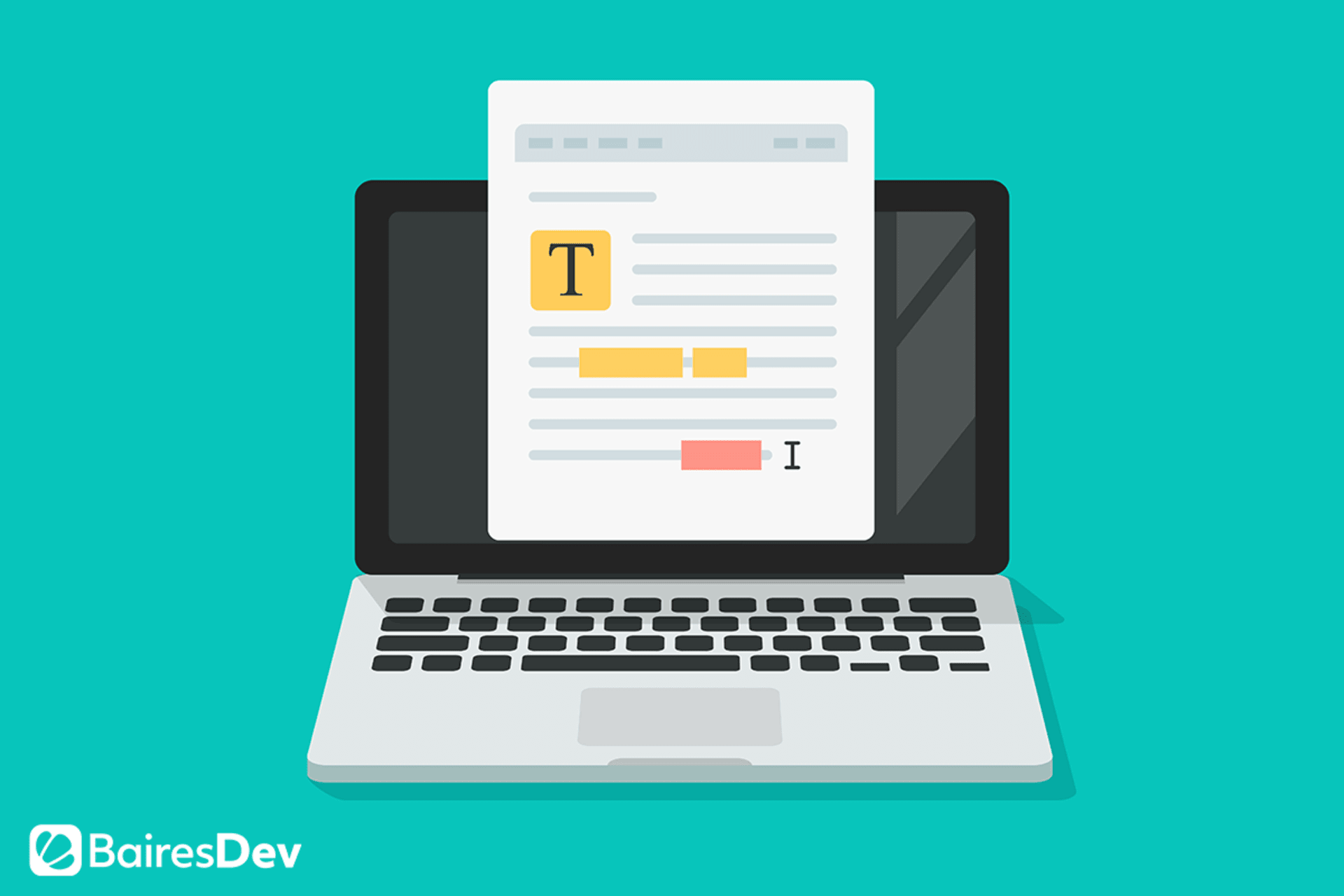A Request for Proposal (RFP) is a business document that contains the details of a specific project. It’s used to request bids from different vendors that you pre-selected because of their capabilities to bring the project to completion. It solicits the candidates to submit a proposal about how they’d tackle the project covering everything from needed resources to costs.
At BairesDev we’ve reviewed countless RFPs and understand how to properly write an effective one that will get you the information you’re looking for from your potential vendors. This template reflects that knowledge and aims to help you build a solid RFP for your vendor research.
As it happens with all templates, this RFP template won’t fit perfectly with all your projects. There will be times when you’ll have to adjust this document to the requirements of the project at hand. In that sense, this template’s objective is to guide you through the writing process of your final RFP, not to replace said document.
After you’re done with it, you’ll have to send the RFP to the software development companies of your choice and await their proposals. If you follow the structure outlined in this document, you’ll surely receive many responses.
Request For Proposal Structure
An RFP has to be comprehensive enough to cover the most important aspects of your project, thus providing a clear picture of what you want to achieve but without being overwhelming. That’s a hard balance to achieve, but you can get to it by including the following items:
- Company contact
- Company description
- Format and timeline for proposals
- Project overview
- Project objectives
- Scope of work and deliverables
- Technical requirements
- Budget details
- Evaluation criteria
Let’s see each one of them and review the reasons why you need them in your RFP.
1. Company contact
The first thing you want to let your potential development providers know is who they’ll be talking to. This comprises two things, the first of which is a specific person that will serve as the liaison between you and the providers. This person could be you, a manager, a team leader, or whoever you want to be in charge of handling the proposals.
It’s not an introduction, mind you, but rather a very brief list of contact information about that person, which should look something like this:
| Name | Phone number | Company Address | |
|
|
2. Company description
The second thing you need to let your providers know to introduce yourself is a brief company description. The key in this section is to be clear rather than overabundant on details – providers need specific information about the company that allows them to better understand your project
Information you should put here includes:
- What do you do
- Which are your main products, services, and specializations
- Who are your customers
- Which markets are you present in
3. Format and timeline for proposals
This section provides your potential partners with the information they’ll need to know how you’ll handle your proposals’ process. Here, you’ll have to detail when you’ll be reaching out to development companies, when you expect them to present their proposals, how long you expect to be analyzing them, and when you are expecting to kick off the project.
Using specific deadlines for all of this will better organize your search and will prompt companies to answer you when you expect them to and in the format you need (which will most likely be a presentation guided by details we’ll discuss later on).
| Event | Date |
| RFP release | |
| Answers to RFP Questions | |
| Proposals Due | |
| Proposal Review | |
| Demonstration (Selected providers) | |
| Contract Execution | |
| Project Kick-off |
4. Project overview
In this section, you’ll lay out some of the most important details about your project so your potential outsourcing partner learns what you’re looking for with it. Keep in mind that this section is more about describing the problem you want to solve rather than the solution you hope to achieve.
Naturally, you’ll also want to include what digital solutions you are imagining and some of their details but you don’t need to completely layout the whole idea here (you’ll do that soon enough).
5. Project objectives
This is probably the most important part of the RFP as it includes the requirements your contractor will need to meet to be considered for your project. Of course, you should include the requirements for the final product and what specific goals you want to accomplish with them. Finally, it’s wise to throw in some details about your target audience here, as engaging with it is pretty much always an objective of all software development projects.
6. Scope of work and deliverables
Here you’ll have to go deeper into your project, explaining the resources you expect to play a role in the project, defining a potential timeline with a deadline for the project’s completion, and establishing a list of deliverables you expect during the lifecycle of your project.
7. Technical requirements
Since we’re talking about software development here, there is plenty of technical information you could include in this section. Try to stick to the essential requirements, namely: technologies you’ll want in the final product, specific features that are a must, and additional features that would be nice to have.
It’s helpful for software development companies to know a little about your current digital environment, mainly because the new product will be integrated into it. That’s why you should also provide details about your existing software solutions, system architecture, and overall environment.
Don’t be afraid to be as thorough as possible here, especially if you’re about to tackle a complex project. A clearer understanding on behalf of the potential providers will give you better estimates that will drive you to make a more informed and precise decision about your future partnership.
8. Budget details
The budget is essential for an RFP because it provides the vendor with an idea of how much money you can/are willing to invest in your digital projects. That’s why you should give a price range or a more detailed budget (if possible), so vendors can know if they are a good financial fit for your project.
Additionally, some vendors might end up helping you reshape your project to fit your budget. They can do so by reprioritizing the work to be done, excluding non-essential elements and features and leaving them for later on. Thus, you might end up having a more manageable project that you can later scale.
9. Evaluation criteria
Finally, you should be explicit about the criteria you’re going to use to evaluate your candidates and pick the one that better suits your needs. This will give vendors a chance to better introduce their experience, expertise, and services while also showing them you’re taking their proposals seriously with solid analysis.
Some of the criteria you can use includes (but are not limited to):
- Overall commitments (especially those related to performance)
- Pricing
- Scope definition
- Technical and operational resolution of the project
- Data security governance
- Proposed methodologies
- Relevant experience in the field
- Compliance with modern regulations
Appendix
Though the formal RFP is covered by the nine points described above, it’s worth noting that you can include an appendix of sorts to gather further information about your potential suppliers. While the RFP will provide you with all the information you need to know if the candidates are capable of handling your project, the data you gather from this appendix will shed further light on those companies and teams, all of which can even end up helping you in making a final decision.
As this isn’t a formal part of the RFP, you can structure it as you want and include the questions you see fit. Here’s a proposed questionnaire that can help you write yours.
About the company
- Can you provide me with the most important details about the company (contact information, online presence, the person in charge of dealing with proposals)?
- Can you give me an overview of the company (number of engineers, expertise, experience, past projects)?
- Can you specify your precise time zone and your team’s English proficiency?
Experience
- Have you worked on projects within the (your industry) industry?
- Can you provide examples of past work in it?
- Could you provide references from past clients I could talk to about your work?
Project management
- What does your entire development lifecycle look like?
- Which methodologies do you use?
- What about your risk mitigation, security, and privacy policies?
Technical experience
- Can you indicate your team’s capabilities in the following areas:
- Continuous integration
- Automated deployments
- Automated testing
- Performance and load testing
- Security testing
- Technical documentation
- Is your team certified in technologies and methodologies? Which ones?
- Please indicate the cutting-edge technologies your team is capable of handling:
- What do your quality assurance and testing practices look like?
Infrastructure and resources
- Which tools do you normally use to develop your products?
- What does your communication model look like?
- How do you source for talent?
- Is the development team assigned to multiple projects at once?
- Do you have the capability to scale up the team quickly as per increasing workload?
Commercial
- How do you estimate the cost of a project?
- Do you have a unique commercial model (fixed price, hourly rates) or offer different options?
- Are maintenance services, support, and upgrades included in the cost? Up until which date does it cover them?
- What currency do you usually issue your invoices?
Additional information
- What does your post-production support look like?
- Are there any benefits to establishing a long-term partnership with your company?
- Are there any other capabilities you wish to tell me about?
- Do you have any extra questions for us?













